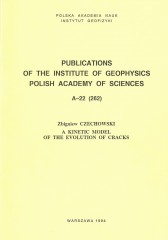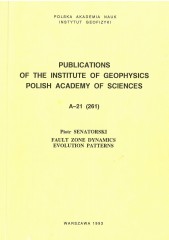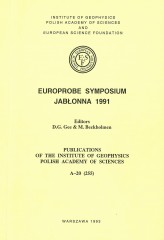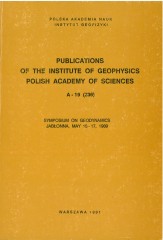BROWSE - VOLUME LIST
- A - Physics of the Earth's Interior
- B - Seismology
-
C - Geomagnetism
C-119, C-118, C-117, C-116, C-115, C-114, C-113, C-112, C-111, C-110, C-109, C-108, C-107, C-106, C-105, C-104, C-103, C-102, C-101, C-100, C-99, C-98, C-97, C-96, C-95, C-94, C-93, C-92, C-91, C-90, C-89, C-88, C-87, C-86, C-85, C-84, C-83, C-82, C-81, C-80, C-79, C-78, C-77, C-76, C-75, C-74, C-73, C-72, C-71, C-70, C-69, C-68, C-67, C-66, C-65, C-64, C-63, C-62, C-61, C-60, C-59, C-58, C-57, C-56, C-55, C-54, C-53, C-52, C-51, C-50, C-49, C-48, C-47, C-46, C-45, C-44, C-43, C-42, C-41, C-40, C-39, C-38, C-37, C-36, C-35, C-33, C-32, C-31, C-30, C-29, C-28, C-27, C-26, C-25, C-24, C-23, C-22, C-21, C-20, C-19, C-18, C-17, C-16, C-15, C-14, C-13, C-12, C-11, C-10, C-9, C-8, C-7, C-6, C-5, C-4, C-3, C-2, C-1
-
D - Physics of the Atmosphere
D-79, D-78, D-77, D-76, D-75, D-74, D-73, D-72, D-71, D-70, D-69, D-68, D-67, D-66, D-65, D-64, D-63, D-62, D-61, D-60, D-59, D-58, D-57, D-56, D-55, D-54, D-53, D-52, D-51, D-50, D-49, D-48, D-47, D-46, D-44, D-45, D-43, D-42, D-41, D-40, D-39, D-38, D-37, D-35, D-34, D-33, D-32, D-31, D-30, D-28, D-27, D-26, D-25, D-24, D-23, D-22, D-21, D-20, D-19, D-18, D-17, D-16, D-15, D-14, D-13, D-12, D-11, D-10, D-9, D-8, D-7, D-6, D-5, D-4, D-3, D-2, D-1
- E - Hydrology
- P - Polar Research
- M - Miscellanea
-
Online First
A - Physics of the Earth's Interior
A Kinetic Model of the Evolution of Cracks
Author(s): Czechowski Z.
Volume: 262
Series: A-22
Volume: 262
Series: A-22
The paper presents a kinetic approach to the problem of evolution of numerous cracks. The ensemble of microcracks is described by the size distribution function of cracks. Using the methods of the kinetic theory of gases, we derive the nonlinear, integro-differential equation of evolution of the size distribution function. We assume that cracks can nucleate with some nucleation rate, propagate with probability P and velocity v, and that they can coalesce with other cracks. The probability of crack fusion is defined by fusion cross-section.
Fault Zone Dynamics Evolution Patterns
Author(s): Senatorski P.
Volume: 261
Series: A-21
Volume: 261
Series: A-21
A model of fault zone dynamics is proposed. Slips along complex fault system, long-range interactions, any distribution of barriers and asperities (modelled by cohesive forces with breakdown strengths and non-zero breakdown slips), a velocity-dependent friction, healing and reactivation of cohesive forces, a circular causality between earthquakes and tectonic stresses are taken into account.
Europrobe Symposium, Jabłonna 1991
Editor(s): Gee D., Beckholmen M.
Volume: 255
Series: A-20
Volume: 255
Series: A-20
In the autumn 1991, Europrobe held a final preparatory meeting in Jabłonna near Warsaw, at the conference centre of the Polish Academy of Sciences. This meeting combined open sessions of lectures with a variety of workshops to make the final preparations for the 1992-93 programme.
Symposium on Geodynamics. Jabłonna, May 15-17, 1989
Author(s):
Volume: 236
Series: A-19
Volume: 236
Series: A-19
This volume contains the papers from Symposium on Geodynamics that took place in Jabłonna on 15-17 May, 1989.
A Parabolic Relation between the Surface Heat Flow and Radiogenic Heat Production for Heat Flow Provinces
Author(s): Maj S.
Volume: 204
Series: A-18
Volume: 204
Series: A-18
A nonlinear (parabolic) relation between the surface heat flow J and radiogenic heat generation Q in crystalline ground for the heat flow provinces is derived.
In this paper certain synthesis and further development or the considered problems is presented. In particular, the parabolic HF-HG relation is deduced for the case of a heat flow province model in which the radiogenic heat production decreases exponentially with depth. The HF-HG relation is also obtained, in a simpler way, from the fundamental heat flow density - thermal conductivity of a rock-layer decreases linearly with increasing temperature.
In this paper certain synthesis and further development or the considered problems is presented. In particular, the parabolic HF-HG relation is deduced for the case of a heat flow province model in which the radiogenic heat production decreases exponentially with depth. The HF-HG relation is also obtained, in a simpler way, from the fundamental heat flow density - thermal conductivity of a rock-layer decreases linearly with increasing temperature.






